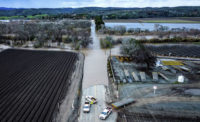A $1.2-billion project to prevent Asian carp and other invasive species from moving into the Great Lakes through Illinois waterways is set to begin construction early next year following a July 1 funding pact reached by Illinois, Michigan and the U.S. Army Corps of Engineers.
The cost-share agreement unlocks $274 million in federal funding, including $226 million from the federal Infrastructure Investment and Jobs Act, as well as $114 million in state funds to build the first of three project components.
The effort to halt the spread of the Asian carp fish population—native to China but introduced into the southern U.S. in the 1970s to keep aquaculture facilities clean—dates back to the early 2000s.
The species has since become a major nuisance in the Mississippi River Basin, with the Corps of Engineers warning that continued upstream trajectory by the carp would have a devastating impact on the entire Great Lakes ecosystem and on the region's estimated $20 billion boating and fishing industries.
Best Chance of Deterrence
Brandon Road Lock and Dam near Joliet, Ill., has been identified as the critical pinch point where layered technologies could be used to stop invasive carp populations. The Brandon Road Interbasin project will install a complex series of innovative deterrents at the site to prevent upstream movement of carp and other aquatic nuisance species on the Illinois Waterway—a system of rivers, lakes and canals that form a shipping link between the Great Lakes and Gulf of Mexico via the Illinois and Mississippi rivers.
The technologies will layer both structural and non-structural control components. Structural measures include technologies such as a flushing lock, an engineered channel with electric barrier, underwater acoustic deterrent, air bubble curtain and an automated barge clearing deterrent.
Non-structural measures, implemented in conjunction with other federal agencies, could include public education and outreach, monitoring, integrated pest management, pesticides, manual or mechanical removal, as well as research and development.
“Our multi-agency team of scientists and engineers has worked tirelessly over the last three years in combination with external stakeholders to design what we believe is an effective solution for protecting the Great Lakes watershed,” said Scott Whitney, project manager for the Corps of Engineers' Rock Island, Ill.-based district, which is overseeing the project.
Pre-construction engineering and design began in December 2020, when the state of Illinois signed a design agreement with the district. Contracts for fabrication, continued design, leading edge deterrents and bedrock removal are now slated for solicitation in coming weeks.




